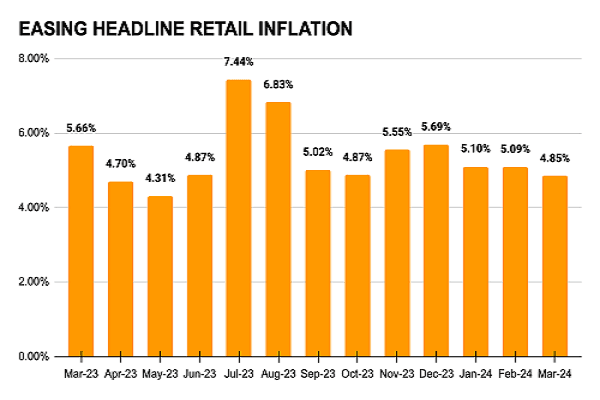India Inflation At 10 Month Low
India's headline retail inflation rate has shown a noteworthy descent, reaching a ten-month low of 4.85 percent, marking a positive turn in the country's economic landscape. This decline, as reported by the Ministry of Statistics and Programme Implementation on April 12, comes as a relief after February's figure stood at 5.09 percent, indicating a progressive trend.
Finding multibagger stocks is important for building wealth. Discover potential multibaggers at Sovrenn Discovery
Stable Monetary Policy Amidst Declining Inflation
The recent data release coincides with the Reserve Bank of India's (RBI) decision to maintain the policy repo rate at 6.5 percent, a stance upheld for the seventh consecutive time by the Monetary Policy Committee (MPC) on April 5. This strategic stability in monetary policy reflects a calculated approach by the central bank amidst evolving economic conditions.
Inflation Trends and Projections
While the CPI inflation has remained within the RBI's tolerance range of 2 to 6 percent for the seventh consecutive month, it has persistently exceeded the medium-term target of 4 percent for a consecutive period of 54 months. The current financial year projects a CPI inflation rate of 4.5 percent, according to the latest forecast by the central bank.
Insights into March CPI Figures
Analyzing the internal dynamics of the March CPI figures, notable trends emerge. Food inflation, a key component, exhibited a marginal softening, settling at 8.52 percent compared to the previous month's 8.66 percent. Conversely, prices of cereals and meat and fish experienced an uptick, while vegetables and pulses displayed a modest decline.

Sector-wise Inflation Analysis
In addition to food, variations were observed in other sectors. Fuel and light inflation witnessed a significant decrease from -0.77 percent in February to -3.24 percent in March, while housing inflation also saw a decline to 2.77 percent from 2.88 percent sequentially. Core inflation, excluding volatile elements such as food and fuel, remained steady at 3.5 percent, indicating a balanced trend.
Investing has built huge wealth for several HNI investors. Learn investing FREE OF CHARGE at Sovrenn Education
Economic Outlook and Risk Factors
Looking ahead, projections suggest that food and beverages inflation is likely to maintain its upward trajectory in April 2024, driven partly by seasonal factors and potential impacts of international crude oil prices. The ongoing increase in crude oil prices could pose a risk to the CPI inflation outlook in the near term, contingent upon the extent of pass-through to retail fuel prices.
Conclusion
In summary, the recent dip in retail inflation coupled with stable monetary policy reflects a promising trajectory for the Indian economy. However, vigilance is warranted as certain sectors and external factors could pose challenges to sustaining this positive momentum, emphasizing the need for prudent economic management and policy interventions.
(An article by Medhansh Bairaria)
Also Read: Indian Government Earnings FY 2023-24:A Closer Look

